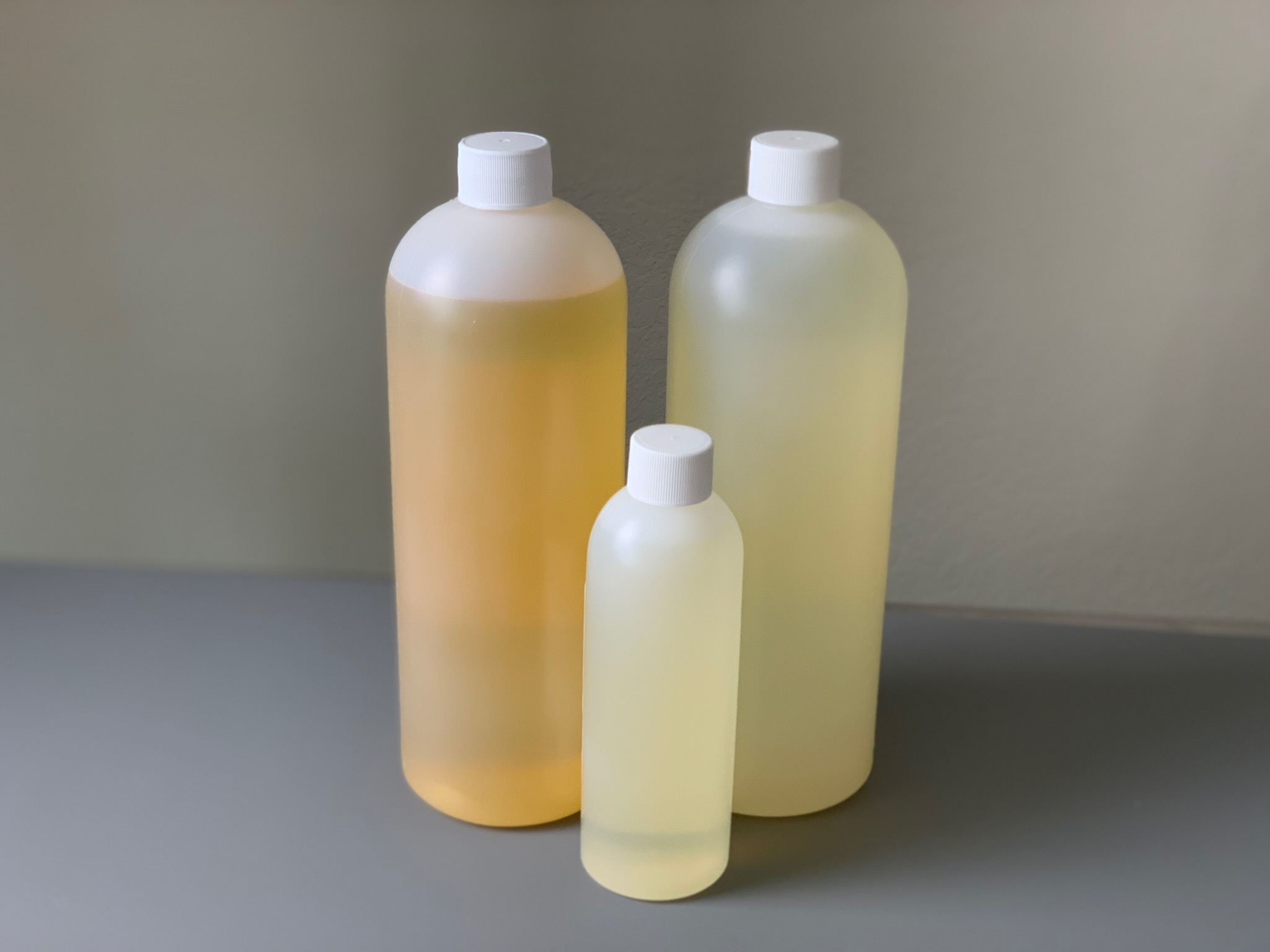
Formulating Shampoo Series
Part 2- Surfactants in Shampoo
Part 3- Custom Shampoo
Surfactants in Shampoo
Surfactants are necessary to remove dirt, oil and product build-up. They are surface-active agents. Surfactants alter and reduce the surface tension allowing for better penetration. They are hydrophilic (water-loving) and lipophilic (oil-loving); they have a water-loving head that is attracted to water and an oil-loving head that is attracted to oil.
Water has an inherent property of surface, a high surface tension. By adding a surfactant, it makes the surface of water more soluble by flattening it out and the surfactant can be used as foaming agent, detergent, emulsification agent and conditioning agent and for solubilizing, depending on the surfactant.
Types
SULFATE SURFACTANTS/CLEANSERS
Sulfate Cleansers can be irritating to the skin. They have high foaming and cleansing actions. Sulfated surfactants are SLS-sodium lauryl sulfate, and ALS-aluminum lauryl sulfate.
SULFATE-FREE SURFACTANTS/CLEANSERS
Sulfate-free cleansers are generally non-irritating and milder than sulfate cleansers.
Categories
There are four categories of surfactants.
1. Anionic Surfactants carry a negative charge.
2. Nonionic Surfactants have no charge.
3. Cationic Surfactants carry a positive charge
4. AmphotericSurfactants carry a negative or positive or no charge.
Anionic Surfactants
Anionic surfactants have a negative charge to the water-loving head, called hydrophilic. Anionic surfactants perform the highest foaming and cleansing actions. They can also build viscosity. Anionic surfactants may be harsh on the skin and hair. Cold process handmade soap is anionic from the reaction of the fats with sodium hydroxide but cold process soap is not harsh on the skin if there is extra oil in the soap. A lot depends on the formulation and the ingredients in the formulation.
Nonionic Surfactants
Nonionic surfactants have no charge to the water-loving head. Nonionic surfactants are one of the gentlest surfactants but they produce very little foam. They are usually combined with other surfactants to boost foam. Nonionic can act as solubilizers and assist with dispersing essential oils.
Cationic Surfactants
Cationic surfactants have a positive charge to their water-loving head. The positive charge creates adherence to the net negative charge of hair. Cationic surfactants are used in conditioning shampoo and hair conditioner to adhere to the hair and not rinsed off the hair, allowing the conditioner to provide conditioning and leave the hair smooth, soft, silky and with less static electricity. Cationic surfactants are good in formulations for co-wash and 2-in-1 conditioning shampoo. Cationic surfactants do not combine well with anionic surfactants.
Amphoteric Surfactants
Amphoteric surfactants can have a negative or positive charge or no charge depending on the acid or alkaline environment. Amphoteric surfactants are generally used as the primary surfactant in mild shampoo formulations.
Active Surfactant Solids
Surfactants contain a detergent and water (glycerin can be part of the water). The detergent is the solid matter and referred to as active. The raw material supplier states the active in % for each surfactant. The supplier may state it as actives, active matter, active substances, solids or activity. For example, in decyl glucoside, generally it is 55% active (solid), the remaining is 45% water. I will talk about why understanding the percentage of actives (solids) helps in developing a shampoo formulation in Part 3.
Natural Surfactants
Natural surfactants should be sulfate-free and from renewable plant sources, biodegradable and use processes that are not harmful to humans, animals and the earth. In a shampoo formulation there is usually a combination of surfactants to provide sufficient foam, manageability for the hair and a good feel when shampooing the hair.
Availability of Surfactants to the Small Manufacturer
These are available to the small manufacturer of natural hair care products have been limited. This is changing and smaller raw material suppliers are offering more surfactants. Here are a few natural surfactants currently available to the small manufacturer. I use these surfactants and others. From my experience, shampoo is one of the most challenging products to formulate. Shampoo performs different depending on the hair type and they are affected by the water used to wash the hair, especially hard water.
-
-
- Apple Surfactant INCI Sodium Cocoyl Apple Amino Acids
Sodium Cocoyl Apple Amino Acids is derived from apple juice amino acids. It is non- irritating, gentle and mild and can be used in baby shampoo and sensitive skin shampoo. Anionic - Potassium Cocoate INCI Potassium Cocoate
Potassium cocoate is also known as liquid soap. I find it harsh on the hair unless combined with more moisturizing surfactants. It is available from a cosmetic raw material supplier or one can make it. It is made with potassium hydroxide (KOH), a similar process like cold process soap. Anionic - Cocamidopropyl Betaine INCI Cocamidopropyl Betaine
Cocamidopropyl Betaine known as CAPB is derived from coconut oil. It is semi-synthetic as it has a synthetic component. It is mild and high foaming, excellent flash foam and improves viscosity (thickens) the formulation. Amphoteric - Coco-Glucoside INCI Coco-Glucoside
Coco-Gllucoside is derived from coconut and sugar. It is a mild surfactant and non-irritating. It has good foaming strength. Nonionic - Decyl Glucoside INCI Decyl Glucoside Decyl Glucoside is derived from sugar and plant oil. It is very mild and non-irritating. It is good for sensitive skin. It does produce a fair amount of foam for being a nonionic surfactant but little flash foam. Nonionic
- Apple Surfactant INCI Sodium Cocoyl Apple Amino Acids
-
Plant Surfactants
Soap bark, soapwort, agave, sarsaparilla and yucca have been used traditionally to cleanse the hair. These will not produce shampoo consumers are familiar with and are challenging to develop a shampoo formulation. They will produce lather but don’t do a good job at cleaning the hair.
Learn More
Learn all about surfactants and the chemistry of surfactants in our Pro Natural Hair Care Course. This course will teach you in-depth about surfactants and the chemistry of surfactants in course lessons.
You might also like

